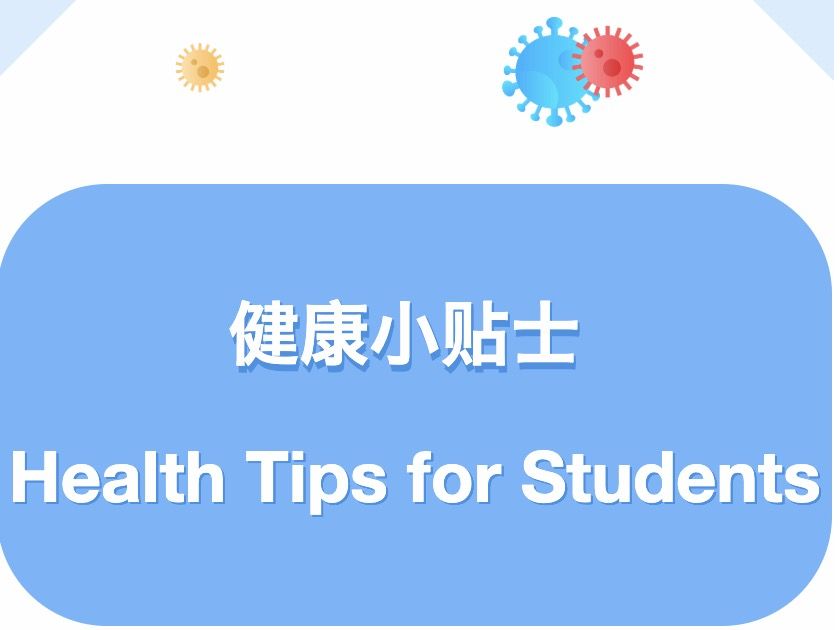
当前正值流感高发季节,学校是人员密集场所,易发生呼吸道传染病的传播。为保障广大同学的身体健康和正常教学秩序,请各位同学认真学习以下流感防控知识,切实履行个人健康责任。
一、认识流感:流感并非普通感冒
流行性感冒(简称“流感”)是由流感病毒引起的急性呼吸道传染病,与普通感冒相比,其传染性更强、传播速度更快,且容易引发肺炎等严重并发症。
典型临床症状:一般表现为急性起病、发热(部分病例可出现高热,达 39-40℃),伴畏寒、寒战、头痛、肌肉、关节酸痛、极度乏力、食欲减退等全身症状,常有咽痛、咳嗽,可有鼻塞、流涕、胸骨后不适、颜面潮红,结膜轻度充血,也可有呕吐、腹泻等症状。部分患者症状轻微或无症状。
核心提示:流感起病急,全身症状重,而普通感冒以上呼吸道卡他症状(如打喷嚏、流清涕)为主,全身症状较轻。
二、传播途径:了解病毒传播方式
流感发病率高,全人群普遍易感,主要通过以下途径实现传播:
1.飞沫传播:感染者咳嗽、打喷嚏或说话时,产生的含有病毒的飞沫被易感者直接吸入。
2.接触传播:病毒附着于物体表面(如门把手、课桌椅、键盘等),通过手接触污染物体后,再触摸口、鼻、眼等黏膜,导致感染。
3.气溶胶传播:在特定场所,如人群密集且密闭或通风不良的房间内,可能存在通过气溶胶传播的风险。
三、个人防护:构筑健康第一道防线
预防流感的关键在于采取科学、有效的个人防护措施:
1.勤洗手:严格按照“七步洗手法”,在流动水下使用肥皂或洗手液洗手,揉搓不少于 20 秒。接触公共物品、餐前便后、咳嗽打喷嚏后,应立即洗手。不具备洗手条件时,可使用含醇速干手消毒剂。
2.常通风:教室和宿舍每日开窗通风 2 至 3 次,每次不少于30 分钟。
3.戴口罩:在教室、图书馆、食堂、实训室等室内公共场所或人员密集区域,应科学佩戴口罩。
4.少聚集:除上课时间外,尽可能减少到人群聚集、空间密闭的场所,如必须前往应戴好口罩。
5.掩口鼻:咳嗽或打喷嚏时,用纸巾或屈肘遮住口鼻,用过的纸巾及时扔到有盖垃圾桶内,并及时洗手。
6.强体魄:保持规律作息,避免熬夜,保证充足睡眠;均衡饮食,加强营养;坚持适度体育锻炼。
7.接疫苗:接种流感疫苗可显著降低罹患流感和发生严重并发症的风险。
四、科学防控:降低身边传播风险
当宿舍或班级内出现流感病例时,应采取以下针对性消杀措施:
1.加强环境通风:立即并持续开窗通风,降低室内病毒浓度。
2.开展终末消毒:对病例居住的宿舍或停留的教室,在其离开后,应对高频接触物体表面进行彻底消毒。可使用有效氯浓度为 500mg/L 的含氯消毒液,对门把手、床栏、桌椅、键盘、鼠标、电灯开关、水龙头等部位进行擦拭消毒。操作时需佩戴手套。
3.做好物品管理:建议流感患者的餐具、水杯等个人用品单独使用、单独清洗消毒。可采用煮沸或蒸汽消毒 15 分钟。
4.规范处理垃圾:患者产生的垃圾(如纸巾、口罩等)应作为医疗废弃物处理,放入专用垃圾袋并密封后,再投入垃圾桶。
5.落实健康监测:与病例有密切接触的同学应加强自我健康监测,一旦出现流感样症状,应立即佩戴口罩,并尽早就医或休息,及时向辅导员报告,避免带病上课或参加集体活动。如出现持续高烧、呼吸困难、胸痛、意识模糊等严重症状,应立即就医。
We are currently in the high-incidence season for influenza. Schools, as crowded settings, are susceptible to the spread of respiratory infectious diseases. To safeguard the health of all students and maintain normal teaching order, students are advised to diligently study the following information on influenza prevention and control and conscientiously fulfill their personal health responsibilities.
I. Understanding Influenza: It Is Not the Common Cold
Influenza is an acute respiratory infectious disease caused by the influenza virus. Compared to the common cold, it is more contagious, spreads more rapidly, and is more likely to cause severe complications such as pneumonia.
Typical Clinical Symptoms: The onset is generally acute, with symptoms including fever (some cases may present with high fever, reaching 39-40°C), often accompanied by chills, rigors, headache, muscle and joint aches, extreme fatigue, loss of appetite, and other systemic symptoms. Sore throat and cough are common, and there may be nasal congestion, runny nose, retrosternal discomfort, facial flushing, and mild conjunctival injection. Vomiting and diarrhea may also occur. Some patients experience mild or no symptoms.
Key Point: Influenza has an acute onset with prominent systemic symptoms, whereas the common cold primarily presents with upper respiratory catarrhal symptoms (such as sneezing, runny nose) and generally milder systemic symptoms.
II. Routes of Transmission: Understanding How the Virus Spreads
Influenza has a high incidence rate, and the general population is susceptible. Transmission occurs primarily through the following routes:
1. Droplet Transmission: When an infected person coughs, sneezes, or talks, virus-containing droplets are directly inhaled by susceptible people.
2. Contact Transmission: The virus attaches to the surface of objects (such as doorknobs, desks and chairs, keyboards). After touching the contaminated objects with hands, people then touch the mucous membranes of the mouth, nose, or eyes, leading to infection.
3. Aerosol Transmission: In specific places ( crowded, enclosed, or poorly ventilated rooms), there may be a risk of transmission through aerosols.
III. Personal Protection: Building the First Line of Defense
The key to preventing influenza lies in adopting scientific and effective personal protective measures:
1. Frequent Hand Hygiene: Strictly follow the "Seven-Step Handwashing Method" — wash hands with soap or hand sanitizer under running water and rub for no less than 20 seconds. Wash hands immediately after touching public objects, before/after meals, or after coughing/sneezing. If handwashing is not possible, use an alcohol-based hand sanitizer.
2. Regular Ventilation: Open windows for ventilation 2-3 times a day in classrooms and dormitories, with each session lasting no less than 30 minutes.
3. Wearing Masks: Scientifically wear a mask in indoor public places (classrooms, libraries, canteens, training rooms) or crowded areas.
4. Avoiding Crowds: Except for class time, minimize visits to crowded and enclosed places. If you must go, wear a mask properly.
5. Covering Coughs and Sneezes: When coughing or sneezing, cover your mouth and nose with a tissue or your elbow. Throw used tissues into a lidded trash can immediately and wash your hands afterward.
6. Strengthening Physical Health: Maintain a regular schedule, avoid staying up late, and ensure adequate sleep; keep a balanced diet to enhance nutrition; insist on moderate physical exercise.
7. Vaccination: Influenza vaccination can significantly reduce the risk of contracting influenza and developing serious complications.
IV. Scientific Prevention and Control: Reducing Transmission Risks in Your Surroundings
When influenza cases are identified in dormitories or classrooms, the following targeted disinfection measures should be implemented:
1. Enhance environmental ventilation:Open windows for immediate and continuous ventilation to reduce the concentration of the virus indoors.
2. Conduct terminal disinfection: After the influenza case leaves, thoroughly disinfect the frequently touched surfaces in the dormitory (where the case lives) or classroom (where the case stays). Use a chlorine-containing disinfectant with an effective chlorine concentration of 500mg/L to wipe and disinfect doorknobs, bed rails, desks and chairs, keyboards, mice, light switches, faucets, etc. Wear gloves during operation.
3. Manage personal items properly: It is recommended that influenza patients use their own tableware, water cups, and other personal items separately, and clean and disinfect them independently. Boiling or steam disinfection for 15 minutes is acceptable.
4. Dispose of garbage properly: Garbage generated by patients (such as tissues, masks) should be treated as medical waste — put it into a special garbage bag, seal it, and then throw it into a trash can.
5. Implement health monitoring: Students who have close contact with the case should strengthen self-health monitoring. Once flu-like symptoms appear, immediately wear a mask, seek medical attention or rest as soon as possible, report to the counselor in a timely manner, and avoid attending classes or group activities while sick. If severe symptoms such as persistent high fever, difficulty breathing, chest pain, or confusion occur, seek medical attention immediately.